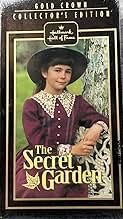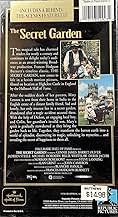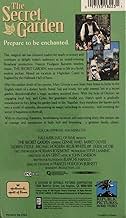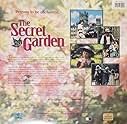Agrega una trama en tu idiomaMary Lennox is sent to live at Misselthwaite Manor where she befriends a young boy and learns about a secret garden.Mary Lennox is sent to live at Misselthwaite Manor where she befriends a young boy and learns about a secret garden.Mary Lennox is sent to live at Misselthwaite Manor where she befriends a young boy and learns about a secret garden.
- Ganó 1 premio Primetime Emmy
- 1 premio ganado en total
- Dirección
- Guionistas
- Todo el elenco y el equipo
- Producción, taquilla y más en IMDbPro
Argumento
¿Sabías que…?
- TriviaThe building used as the house, Highclere Castle, is not only the seat of the Earl of Carnarvon who helped find Tutankhamen's tomb in 1922, but also was the filming location of the British drama Downton Abbey (2010).
- ConexionesEdited into Hallmark Hall of Fame (1951)
- Bandas sonorasNocturne in E Minor Op. 72 No. 1
Composes by Frédéric Chopin (as F. Chopin)
Opinión destacada
The 1987 TV version of The Secret Garden is one that follows the book and includes several things that were left out of the later 1993 version, but there are some things that are not done correctly or that are not even remotely suggested in the book and have no place at all in the movie. There is an unnecessary inclusion of Mary as an older woman, reminiscing about her times in the secret garden at Misselthwaite Manor, which changes the entire film from an adventure tale of a young girl in a strange atmosphere to one of a flashback of a girl who grew into exactly the kind of person that the movie is trying to convince kids not to grow into. On one hand, I understand that this emphasizes the idea (very popular in children's literature) that at no point in any adult's life should they ever let go of their childhood completely, but it also presents the older Mary's life as missing something that was there in her childhood. Late in the film, as one of the awful artistic liberties taken with this version of the book, we learn with enormous dismay what that thing is.
There is a much more graphic depiction of the cholera scenario that killed her parents than there was in the 1993 version, which director Alan Grint uses both to emphasize the extent of how spoiled Mary is (`Said is dead and there's no one to dress me or make me breakfast!') as well as to take another completely unnecessary creative liberty with the story, this time throwing in a scene where it seems that Mary has also been infected with cholera. After complaining that there's no one to dress and feed her, she wanders out to the dinner table, still covered with the leftovers from last night's feast, and she starts nibbling here and there and taking sips from all of the half empty wine glasses. We learn for the rest of the film that Mary is too stuck up to accept anything but the best of everything, yet in this scene she is suddenly willing to scrounge around like a lowly scavenger animal.
After helping herself to the leftovers, Mary gets a little drunk and staggers to her bed, where she collapses, dripping sweat, and we are treated to some of the enormously creepy music that accompanies much of the film. The supernatural element of the story is enhanced as much as possible in this movie, which increases the effect that the 1993 version also had, which was to reduce the inherent Magic of the garden and render it little more than an escape from the sheer creepiness of the Manor. The Manor itself was enormous and looming from the outside, just like in the novel, but then we see that the halls on the inside are no more impressive than a hotel.
These are relatively small and forgivable discrepancies, however (or at least they become small and forgivable compared to the jaw-droppingly awful ending), and most of the rest of the film is in the right place. Gennie James gives a satisfactory performance as Mary (who is MEANT to be a dislikable character). Barret Oliver and Jadrien Steele, however, are miscast in their roles as Dickon and Colin, respectively, if only because they are meant to be the same age as Mary, but they are played by actors who are about 12 and 13 years old, while Gennie James was only about 9 or 10 when the movie was made. The age difference shows very clearly in the film.
The character of Dickon, as with the rest of the movie, is written with a greatly enhanced mystical side, playing him up as a supernatural character rather than a boy who has spent so much time outdoors with nature that he has developed an unusual closeness to it. He is transferred from being a fun- and nature-loving boy in the novel to a mystical witch doctor who can foresee the future, make statements about fate, and carry squirrels around in his pocket not like they're his friends and pets, like in the book, but like they are his own offspring, unable to survive without him. When Mary tells him that she found the key to the secret garden, Dickon says, `You found the door,' and then looks away dreamily and continues, `it was meant to be ' Oh, PLEASE.
Archibald Craven is again a wonderful character, as he was in the 1993 version, although Derek Jacobi is not able to capture the same depth of mysterious sadness and closed off suffering that John Lynch was able to, and again here, neither Lord Craven nor Colin is ever once presented as having even the slightest bit of a hunchback. Why is this left out of these film versions? When we first meet Lord Craven in this film (in a scene in the library that is so creepy that it almost cancels out the effect of the meeting entirely), he is very much hunched over, but he becomes perfectly straight by the next time he is seen.
The worst discrepancy from the book, however (besides the ending, but I'll get to that later), is the scene where Mary is finally fed up with Colin's screaming and crying and storms into his room to shut him up once and for all. It starts out okay, with Mary screaming at him that she thinks everyone should just let him scream himself to death, but when he says that he screams because he is going to grow up to be a hunchback like his father, Mary asks if she might be allowed to see the lump on his back, using a level of politeness that her character would not even be able to fathom. She does this again in the scene where she asks Lord Craven if she might be allowed a small piece of land, coming off as a terrified child more than one with ulterior motives, as in the novel.
One of the weak points of the novel is that the moral is handed directly to the reader at the beginning of Chapter 17, and this is left out in both this and the 1993 versions, thankfully, but this one turns around and adds in an equally ham-handed moral. It starts off with Ben Weatherstaff's entrance into the garden, which is not done under Colin's strict orders as in the novel, and then Colin weakly stands for a second for Ben, rather than forcing himself to stand the entire time he's there, not wishing to give in in front of him. Shortly after this scene, Mary explains to Colin, `Ugly thoughts are like thistles, pretty thoughts are like roses. I used to have so many ugly thoughts in my head that I had no room for pretty ones.' Very cute, but did we really need to have it fed to us like that?
I was glad to see here a lot of things from the novel that were left out of the 1993 version, such as Bob Haworth's exercises that Dickon teaches to Colin to strengthen his legs, Colin's goal to become a scientist and lecturer and experimenter, and something of Dickon's family, even though all we see is his mother and not his massive amount of siblings, but it's just too bad that the movie feels that there is so much that needs to be added to the story. There is no romance in Frances Hodgson Burnett's The Secret Garden (although there are small hints at childish versions of it), yet in this film adaptation they evidently were so desperate to add some cheesy romance in that they completely changed the story. Dickon joined the war and was killed, and Mary returns to the secret garden to embrace her wonderful memories of it (she is also still wearing her nurse's uniform, showing that she was so determined to serve in the war that she doesn't take off her uniform even when she's off duty), and Colin shows up, still so weak in the legs that he has to walk with a cane.
First we are forced to wonder how Colin managed to get into the military when he can barely stand on his own feet without help, and then we have to see Mary tell him that she never answered his letters, in which he repeatedly asks her to marry her, because she wanted it to happen in their garden. Again, very cute, but fans of the novel, if they haven't already, will be slapping their foreheads in disbelief that writer Blanche Hanalis felt the ridiculous need to add something like this into a movie based on a book that is already more than able to stand on its own, as are all of its characters by the end of the story. There is no need for extraneous things like Dickon's death and the marriage of Colin and Mary because, as this movie shows, such additions into the story can only cause problems and make it trip over itself.
There is a much more graphic depiction of the cholera scenario that killed her parents than there was in the 1993 version, which director Alan Grint uses both to emphasize the extent of how spoiled Mary is (`Said is dead and there's no one to dress me or make me breakfast!') as well as to take another completely unnecessary creative liberty with the story, this time throwing in a scene where it seems that Mary has also been infected with cholera. After complaining that there's no one to dress and feed her, she wanders out to the dinner table, still covered with the leftovers from last night's feast, and she starts nibbling here and there and taking sips from all of the half empty wine glasses. We learn for the rest of the film that Mary is too stuck up to accept anything but the best of everything, yet in this scene she is suddenly willing to scrounge around like a lowly scavenger animal.
After helping herself to the leftovers, Mary gets a little drunk and staggers to her bed, where she collapses, dripping sweat, and we are treated to some of the enormously creepy music that accompanies much of the film. The supernatural element of the story is enhanced as much as possible in this movie, which increases the effect that the 1993 version also had, which was to reduce the inherent Magic of the garden and render it little more than an escape from the sheer creepiness of the Manor. The Manor itself was enormous and looming from the outside, just like in the novel, but then we see that the halls on the inside are no more impressive than a hotel.
These are relatively small and forgivable discrepancies, however (or at least they become small and forgivable compared to the jaw-droppingly awful ending), and most of the rest of the film is in the right place. Gennie James gives a satisfactory performance as Mary (who is MEANT to be a dislikable character). Barret Oliver and Jadrien Steele, however, are miscast in their roles as Dickon and Colin, respectively, if only because they are meant to be the same age as Mary, but they are played by actors who are about 12 and 13 years old, while Gennie James was only about 9 or 10 when the movie was made. The age difference shows very clearly in the film.
The character of Dickon, as with the rest of the movie, is written with a greatly enhanced mystical side, playing him up as a supernatural character rather than a boy who has spent so much time outdoors with nature that he has developed an unusual closeness to it. He is transferred from being a fun- and nature-loving boy in the novel to a mystical witch doctor who can foresee the future, make statements about fate, and carry squirrels around in his pocket not like they're his friends and pets, like in the book, but like they are his own offspring, unable to survive without him. When Mary tells him that she found the key to the secret garden, Dickon says, `You found the door,' and then looks away dreamily and continues, `it was meant to be ' Oh, PLEASE.
Archibald Craven is again a wonderful character, as he was in the 1993 version, although Derek Jacobi is not able to capture the same depth of mysterious sadness and closed off suffering that John Lynch was able to, and again here, neither Lord Craven nor Colin is ever once presented as having even the slightest bit of a hunchback. Why is this left out of these film versions? When we first meet Lord Craven in this film (in a scene in the library that is so creepy that it almost cancels out the effect of the meeting entirely), he is very much hunched over, but he becomes perfectly straight by the next time he is seen.
The worst discrepancy from the book, however (besides the ending, but I'll get to that later), is the scene where Mary is finally fed up with Colin's screaming and crying and storms into his room to shut him up once and for all. It starts out okay, with Mary screaming at him that she thinks everyone should just let him scream himself to death, but when he says that he screams because he is going to grow up to be a hunchback like his father, Mary asks if she might be allowed to see the lump on his back, using a level of politeness that her character would not even be able to fathom. She does this again in the scene where she asks Lord Craven if she might be allowed a small piece of land, coming off as a terrified child more than one with ulterior motives, as in the novel.
One of the weak points of the novel is that the moral is handed directly to the reader at the beginning of Chapter 17, and this is left out in both this and the 1993 versions, thankfully, but this one turns around and adds in an equally ham-handed moral. It starts off with Ben Weatherstaff's entrance into the garden, which is not done under Colin's strict orders as in the novel, and then Colin weakly stands for a second for Ben, rather than forcing himself to stand the entire time he's there, not wishing to give in in front of him. Shortly after this scene, Mary explains to Colin, `Ugly thoughts are like thistles, pretty thoughts are like roses. I used to have so many ugly thoughts in my head that I had no room for pretty ones.' Very cute, but did we really need to have it fed to us like that?
I was glad to see here a lot of things from the novel that were left out of the 1993 version, such as Bob Haworth's exercises that Dickon teaches to Colin to strengthen his legs, Colin's goal to become a scientist and lecturer and experimenter, and something of Dickon's family, even though all we see is his mother and not his massive amount of siblings, but it's just too bad that the movie feels that there is so much that needs to be added to the story. There is no romance in Frances Hodgson Burnett's The Secret Garden (although there are small hints at childish versions of it), yet in this film adaptation they evidently were so desperate to add some cheesy romance in that they completely changed the story. Dickon joined the war and was killed, and Mary returns to the secret garden to embrace her wonderful memories of it (she is also still wearing her nurse's uniform, showing that she was so determined to serve in the war that she doesn't take off her uniform even when she's off duty), and Colin shows up, still so weak in the legs that he has to walk with a cane.
First we are forced to wonder how Colin managed to get into the military when he can barely stand on his own feet without help, and then we have to see Mary tell him that she never answered his letters, in which he repeatedly asks her to marry her, because she wanted it to happen in their garden. Again, very cute, but fans of the novel, if they haven't already, will be slapping their foreheads in disbelief that writer Blanche Hanalis felt the ridiculous need to add something like this into a movie based on a book that is already more than able to stand on its own, as are all of its characters by the end of the story. There is no need for extraneous things like Dickon's death and the marriage of Colin and Mary because, as this movie shows, such additions into the story can only cause problems and make it trip over itself.
- Anonymous_Maxine
- 7 mar 2003
- Enlace permanente
Selecciones populares
Inicia sesión para calificar y agrega a la lista de videos para obtener recomendaciones personalizadas
Detalles
- Fecha de lanzamiento
- Países de origen
- Idioma
- También se conoce como
- Hallmark Hall of Fame: The Secret Garden (#37.1)
- Locaciones de filmación
- Highclere Castle, Highclere, Hampshire, Inglaterra, Reino Unido(Mistlethwaite Manor)
- Productoras
- Ver más créditos de la compañía en IMDbPro
Contribuir a esta página
Sugiere una edición o agrega el contenido que falta

Principales brechas de datos
What is the German language plot outline for The Secret Garden (1987)?
Responda






























